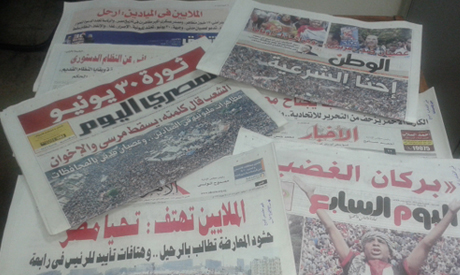
Egyptian Newspapers (Photo: Ali Nada)
The front pages of Egypt's major newspapers, including the Muslim Brotherhood's Freedom and Justice Party (FJP), showed photos of Sunday's mass protests across the country, although the squares and relative headlines varied between public and private newspapers.
Al-Akhbar, Egypt's state owned newspaper, used "volcano of anger" to describe the avalanche of protests, vaguely referring to the pro-Morsi protest in Rabaa Al-Adawiya Square in Cairo's Nasr City, and included photos of both protests. News about President Mohamed Morsi's whereabouts and the situation otherwise in the country did not start until the ninth page.
Al-Ahram, the widest-circulating newspaper, which had traditionally been the 'voice of the regime' also acknowledged the escalating events and millions chanting "long live Egypt" with a photo from Cairo's Tahrir Square. News of Morsi's interview with the Guardian came on the second page. A number of articles referred to the army's role in protecting public buildings and securing Sinai.
Independent newspapers were mostly biased towards the "30 July Revolution." One of Al-Masry Al-Youm's headlines, the top-selling private newspaper in the country, mentioned the start of civil disobedience in governorates outside Cairo, detailing stories from Daqahliya, Menoufiya, Qalioubiya and Beheira where protesters closed the local governorate buildings, preventing anyone from entering. A full page was dedicated to the police force movements, including refusing to protect the Brotherhood buildings and march they staged while wearing Tamarod (Rebel) t-shirts.
The Freedom and Justice Party's newspaper had Morsi's statements to the Guardian in the headlines, "Morsi: I will not allow any 'deviation' from the constitutional regime," detailing out the interview in the front page. "Rabaa [Al-Adawiya] sit-in blows the trumpet" was the second headline with photos of the packed square, followed by news that 'Rebel' campaign 'militias' prevented marches in Suez and Qalioubiya that 'supported legitimacy.' The newspaper's headlines were focused on how 'the anti-revolution forces' and 'thugs' are having their way throughout the country and how the opposition is stifling Morsi. Two pages were dedicated to commemorate the 'martyrs of legitimacy,' including El-Husseini Abu-Deif (Egyptian journalist, who was shot during presidential palace clashes in December 2012, whose fiancé and family claims was against the Brotherhood, yet the group claims he was a supporter). The newspaper did not mention the army or police except in one incident of 'catching illegal weapons, but without using the word 'police' and instead 'security apparatus.'
Al-Watan, recently-founded, widely-known independent newspaper, had one large photo of anti-Morsi protesters with a headline that read "We are the legitimacy." Photos of protesters with a crossed-out photo of Anne Patterson titled "Hating Obama" was also headlined. The newspaper, rumoured to support the "old regime," covered news of state institutions revolting, including the judges, intellectuals, and journalists marches against Morsi. Al-Watan also reported records of absence from ministries and public offices, claiming they "reached 60 percent in the local development ministry, 70 percent in agriculture ministry, 50 percent in health and education ministries" and 30 percent in tourism, while no one showed up at the ministries of organization and management, culture, and endowments.
Al-Youm Al-Sabe independent newspaper described the day as "Millions in the streets and squares," "Marches towards the presidential palace," and "Chanting leave, leave." Yet, the newspaper dedicated the second page to an open debate between leaders of the two campaigns Tamarud ('Rebel') and Tagarud and the third page focused on Morsi's Guardian interview and the army's actions to "secure" entrances and exists to the country and to Greater Cairo. The back cover of the paper that was nearly divided equally between covering pro-Morsi and anti-Morsi campaigns traced some differences between the two protests across 10 items, including the chants, the way to call for the protests and mobilise. They termed pro-Morsi protesters as "Protesters, Brotherhood and Salafists" while the anti-Morsi are "Protesters, couch-party and remnants of old regime."
Among the independent newspapers, Al-Shorouk's headlines started with "Millions in the squares: Leave" and the presidency's call for 'talks.' The photos of the squares lit at night were titled "The people want to topple the Brotherhood." In three different spots on the first page headlines, they quote a "military source" who stated that "The message of the millions hasn't reached the Brotherhood."
Tahrir independent newspaper, whose chief editor Ibrahim Eisss is a renowned media presenter and writer, covered the entire first page with one photograph of Tahrir protests with the large headline that read: "Live the people … Millions of Egyptians toppled the rule of the Brotherhood in the squares." The entire newspaper covered events of the first revolutionary day across the country by covering stories about various organised groups, the army, opposition, journalists, judges and Al-Azhar sheikhs, including the international newspapers coverage.
Short link: